Analysis of Axial Compression Performance of Concrete Stub Column with CRB600H Stirrups
Abstract
1. Introduction
2. Finite Element Analysis Model of Stub Columns under Axial Compression
2.1. Constitutive Model of Concrete
2.2. Constitutive Model of Steel
2.3. Verification of Finite Element Calculation Results
3. Analysis of Axial Compression Performance of CRB600H Stirrup Concrete Stub Columns
3.1. Effect of Stirrup Strength
3.1.1. Equal Volume Replacement of Stirrup
3.1.2. Equal Strength Replacement of Stirrup
3.2. Effect of Stirrup Construction
3.3. Effect of Stirrup Spacing
3.4. Effect of Concrete Strength
4. Calculation Method of Bearing Capacity of Axial Compression Columns with High Strength Stirrups
4.1. Calculation of Bearing Capacity under Axial Compression
4.1.1. Code for Design of Concrete Structures (GB50010-2010) [26]
4.1.2. Code for Design of Concrete Structures in ACI [29]
4.1.3. Theoretical Values of Axial Bearing Capacity
4.2. Improvement of Axial Compression Bearing Capacity Formula Considering Stirrup Effect
5. Results and Discussion
6. Conclusions
- (1)
- With CRB600H stirrups and HRB400 stirrups, their peak bearing capacity is close to each other. The ductility of concrete columns with CRB600H stirrups is improved, and the deformation capacity is better after peak load.
- (2)
- Compared with A-type stirrups and C-type stirrups, B-type stirrups have the best restraining effect on concrete, the peak bearing capacity of the specimens is higher, the descending section of load-displacement curve is smoother, and they have better ductility.
- (3)
- With the decrease in stirrup spacing, the peak bearing capacity and ductility of specimens are higher; with the increase in concrete strength, the peak bearing capacity of the specimen is increased, but the ductility of the specimen is reduced.
- (4)
- Since the constraining effect of the stirrups on concrete in the core area is not considered in the existing code formula, based on the results of the parameter analysis, this paper proposes the effective confinement index (keλt). Compared with the numerical simulation and test results, the calculation formula proposed in this paper is more accurate than the existing code formula.
Author Contributions
Funding
Data Availability Statement
Acknowledgments
Conflicts of Interest
References
- Wang, Y.; Tian, Q.; Lan, G.; Yao, S.; Zhang, J.; Liu, X. Experimental research on the mechanical properties of concrete column reinforced with 630MPa high-strength steel under large eccentric loading. J. Jilin Univ. Eng. Technol. Ed. 2022, 11, 2626–2635. [Google Scholar]
- Kent, D.C.; Park, R. Flexural members with confined concrete. J. Struct. Div. 1971, 97, 1969–1990. [Google Scholar] [CrossRef]
- Sheikh Shamim, A.; Uzumeri, S.M. Analytical model for concrete confinement in tied columns. J. Struct. Div. 1982, 108, 2703–2722. [Google Scholar] [CrossRef]
- Mander, J.B.; Priestley, M.J.N.; Park, R. Observed Stress-Strain Behavior of Confined Concrete. J. Struct. Eng. 1988, 114, 1827–1849. [Google Scholar] [CrossRef]
- Mander, J.B.; Priestley, M.J.N.; Park, R. Theoretical Stress-Strain Model for Confined Concrete. J. Struct. Eng. 1988, 114, 1804–1826. [Google Scholar] [CrossRef]
- Madas, P.; Elnashai, A.S. A new passive confinement model for the analysis of concrete structures subjected to cyclic and transient dynamic loading. Earthq. Eng. Struct. Dyn. 1992, 21, 409–431. [Google Scholar] [CrossRef]
- Cusson, D.; Paulter, P. High-strength concrete columns confined by rectangular ties. J. Struct. Eng. 1994, 120, 783–804. [Google Scholar] [CrossRef]
- Cusson, D.; Paulter, P. Stress-strain model for confined high-strength concrete. J. Struct. Eng. 1995, 121, 468–477. [Google Scholar] [CrossRef]
- Saatcioglu, M.; Razvi, S.R. High-Strength Concrete Columns with Square Sections under Concentric Compression. Eng. Struct. 1998, 124, 1438–1447. [Google Scholar] [CrossRef]
- Razvi, S.; Saatcioglu, M. Confinement Model for High-Strength Concrete. Eng. Struct. 1999, 125, 281–289. [Google Scholar] [CrossRef]
- Shi, Q.; Yang, K.; Liu, W.; Zhang, X.; Jiang, W. Experimental study on mechanical behavior of high strength concrete confined by high-strength stirrups under concentric loading. Eng. Mech. 2012, 29, 141–149. [Google Scholar]
- Shi, Q.; Wang, N.; Tian, Y.; Wang, P.; Li, K. Study on stress-strain relationship of high-strength concrete confined with high-strength stirrups under axial compression. J. Build. Struct. 2013, 34, 144–151. [Google Scholar]
- Yang, K.; Shi, Q.; Zhao, J. Study on the constitutive model of high-strength concrete confined by high-strength stirrups. China Civ. Eng. J. 2013, 46, 34–41. [Google Scholar]
- Li, H.; Teng, J.; Li, Z.; Wang, Y.; Zou, D. Experimental study of damage evolution in cuboid stirrup-confined concrete. Mater. Struct. 2015, 49, 2857–2870. [Google Scholar] [CrossRef]
- Li, Z.; Peng, Z.; Teng, J.; Wang, Y. Experimental Study of Damage Evolution in Circular Stirrup-Confined Concrete. Materials 2016, 9, 278. [Google Scholar] [CrossRef] [PubMed]
- Li, Y.; Cao, S.; Jing, D. Axial compressive behaviour of RC columns with high-strength MTS transverse reinforcement. Mag. Concr. Res. 2017, 69, 436–452. [Google Scholar] [CrossRef]
- Li, Y.; Cao, S.; Jing, D. Analytical compressive stress-strain model for concrete confined with high-strength multiple-tied-spiral transverse reinforcement. Struct. Des. Tall Spéc. Build. 2017, 27, e1416. [Google Scholar] [CrossRef]
- Li, Y. Experimental and Theoretical Research on Mechanical Behavior of RC Columns with 600MPa Reinforcing Bars. Ph.D. Thesis, Southeast University, Nanjing, China, 2019. [Google Scholar]
- Sun, L.; Ma, Q.; Han, F.; Liu, Z.; Li, J.; Wang, P.; Zhao, H.; Sun, J. Experimental investigation on axial compression behavior of steel reinforced concrete columns with welded stirrups. Eng. Struct. 2019, 208, 109924. [Google Scholar] [CrossRef]
- Hou, C.; Zheng, W.; Chang, W. Behaviour of high-strength concrete circular columns confined by high-strength spirals under concentric compression. J. Civ. Eng. Manag. 2020, 26, 564–578. [Google Scholar] [CrossRef]
- Jaafar, K.; Sikora, K. Analytical confinement model for square section confined with circular ties. Aust. J. Struct. Eng. 2020, 21, 218–233. [Google Scholar] [CrossRef]
- Liu, C.; Deng, Y.; Fang, D. Study on axial compression capacity of innovative five-spiral stirrup for rectangular short columns. J. Southwest Jiaotong Uni. 2022, 57, 1157–1164+1174. [Google Scholar]
- Liu, C.; Zhou, C. Research on the axial compression performances of five-spiral short circular columns. J. Railw. Eng. Soc. 2021, 38, 97–102. [Google Scholar]
- Chang, Y.; Shi, J.; Hou, Y.; Lu, T. Experimental study on the axial compression capacity of ultra-high performance concrete stub column confined with stirrups. Acta Mater. Compos. Sin. 2022, 39, 3451–3461. [Google Scholar]
- Liu, J.; Liu, L. Experimental study on influence of straightening and corrosion on CRB600H steel bars mechanical and anchorage performance. Build. Struct. 2021, 51, 56–62. [Google Scholar]
- Ministry of Housing and Urban-Rural Development of the People’s Republic of China. Code for Design of Concrete Structures GB 50010-2010; Ministry of Housing and Urban-Rural Development of the People’s Republic of China: Beijing, China, 2015. [Google Scholar]
- Liu, L. Experimental Research on Seismic Shear Behavior of Reinforced Concrete Columns with CRB600H High-Strength Stirrups. Ph.D. Thesis, Chongqing University, Chongqing, China, 2019. [Google Scholar]
- Bai, J.; Li, S.; Zhu, Y. Seismic performance of high strength concrete columns confined by welded hoop stirrups. J. Vib. Shock 2021, 40, 75–84. [Google Scholar]
- ACI (American Concrete Institute). Building Code Requirements for Structural Concrete ACI 318–319; ACI: Farmington Hills, MI, USA, 2019. [Google Scholar]
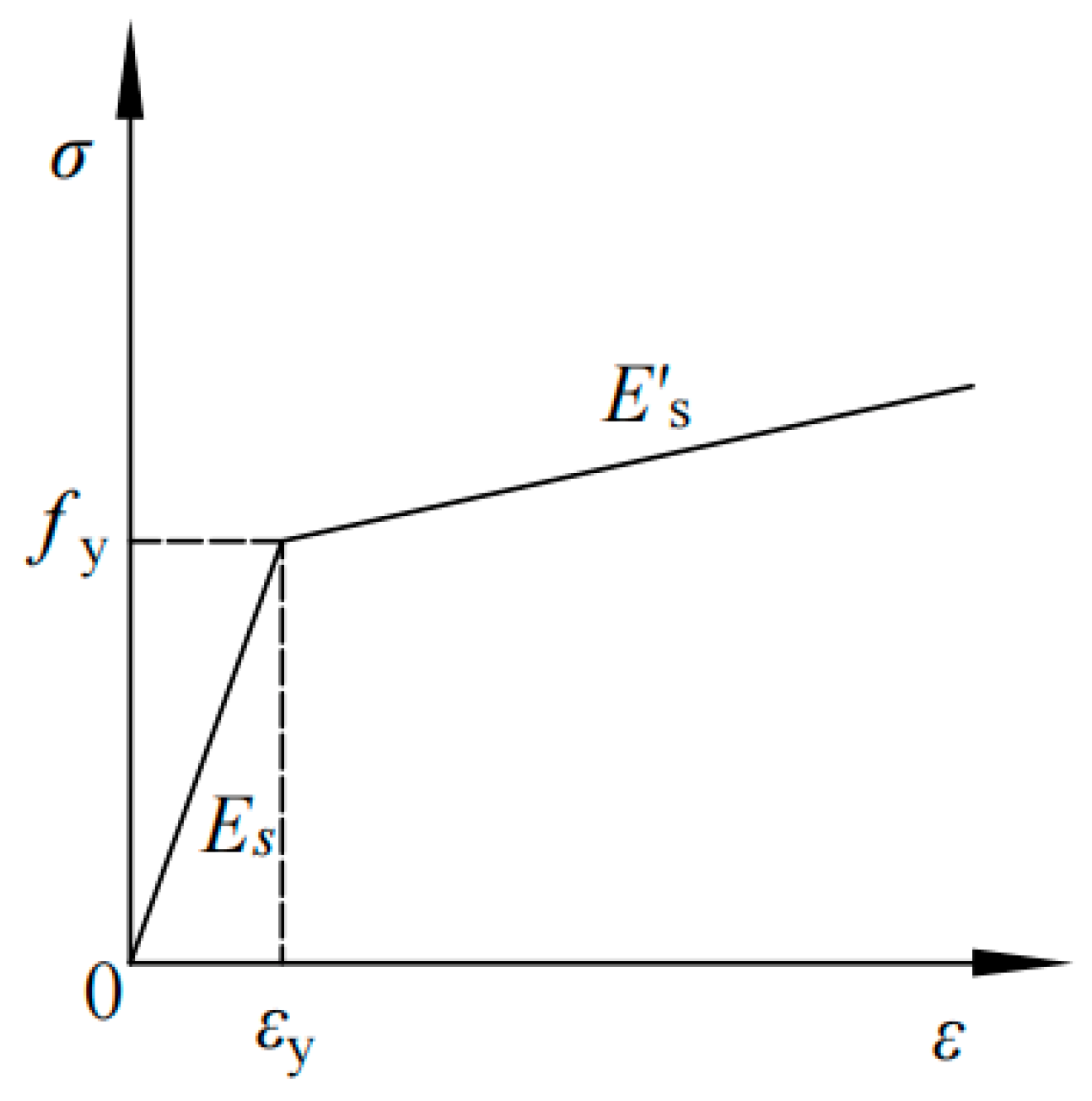
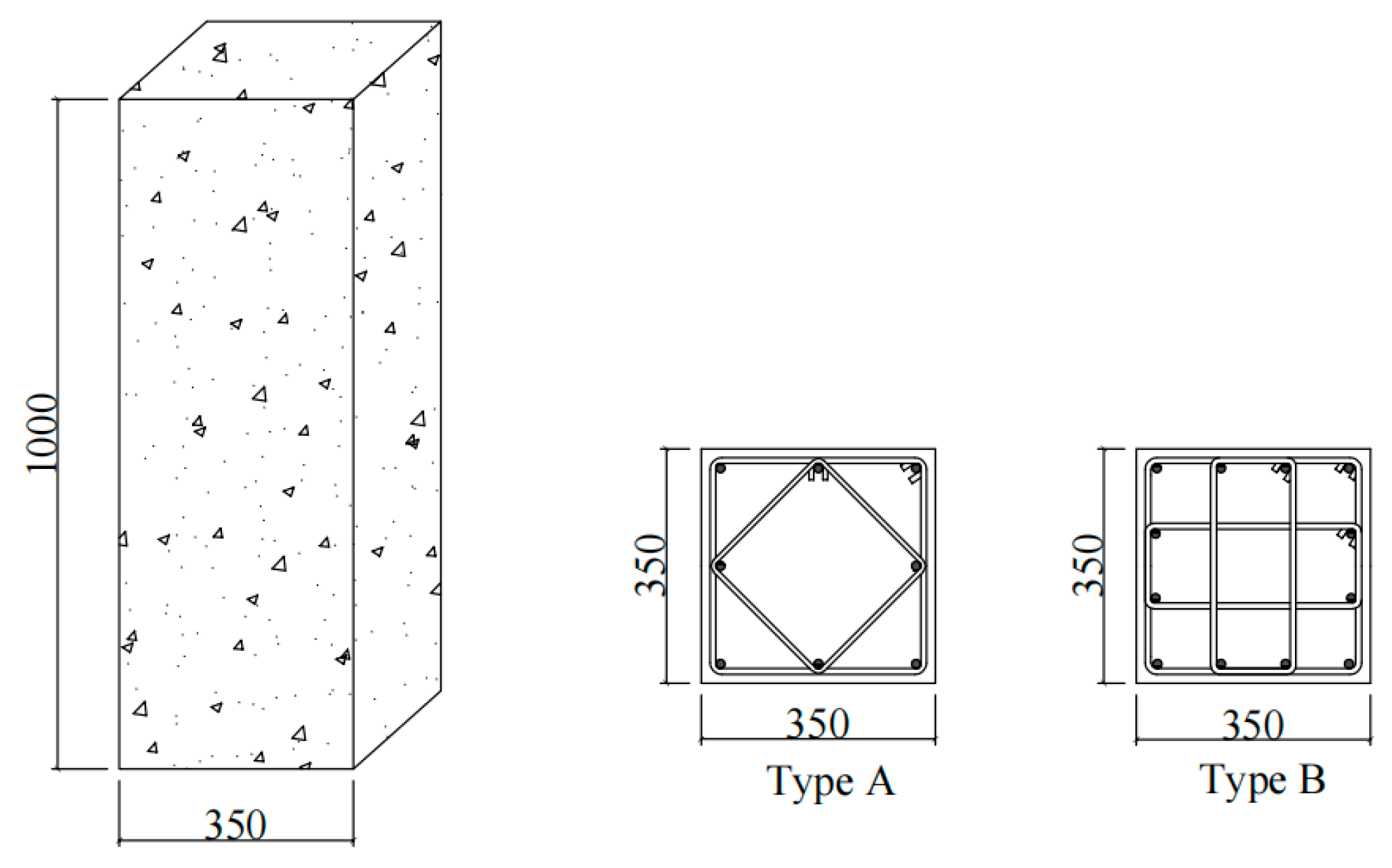

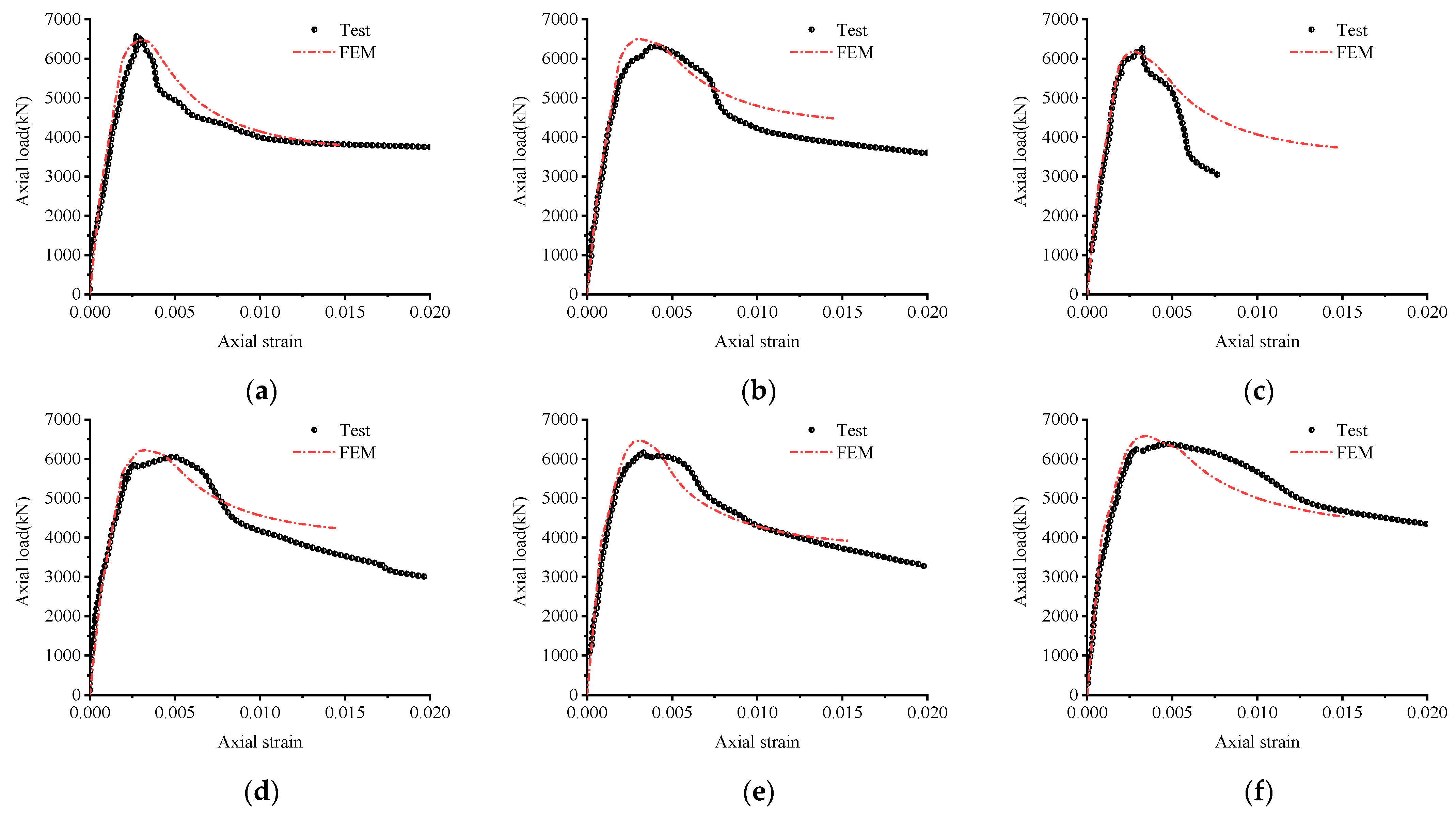

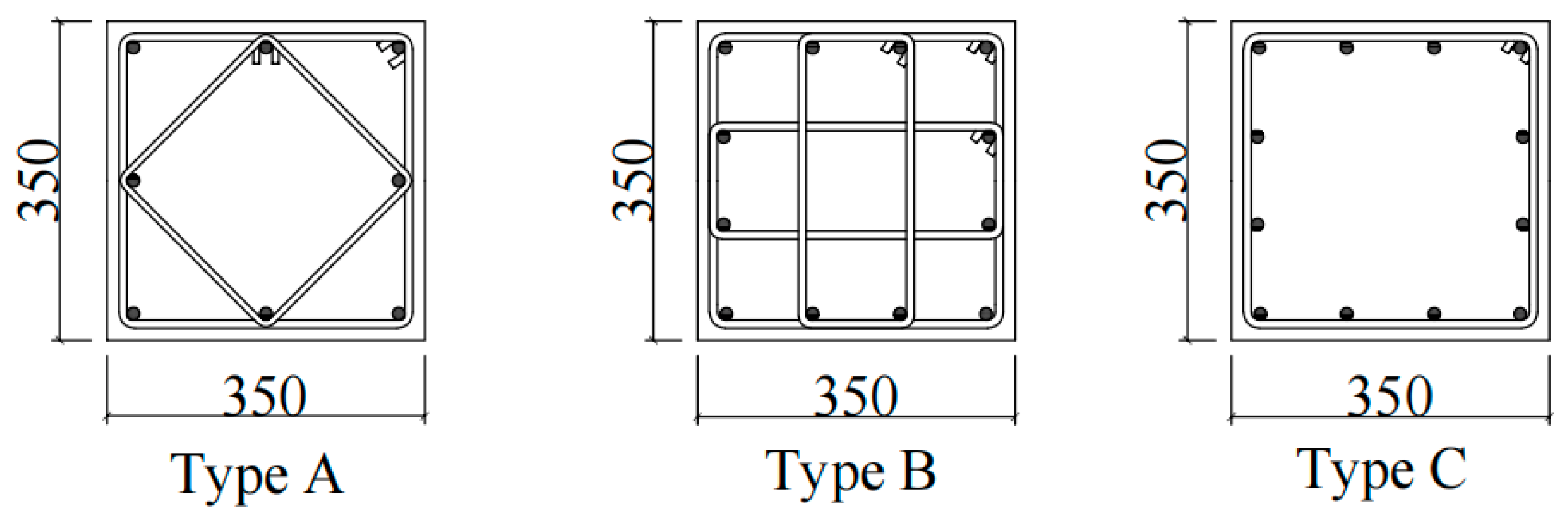
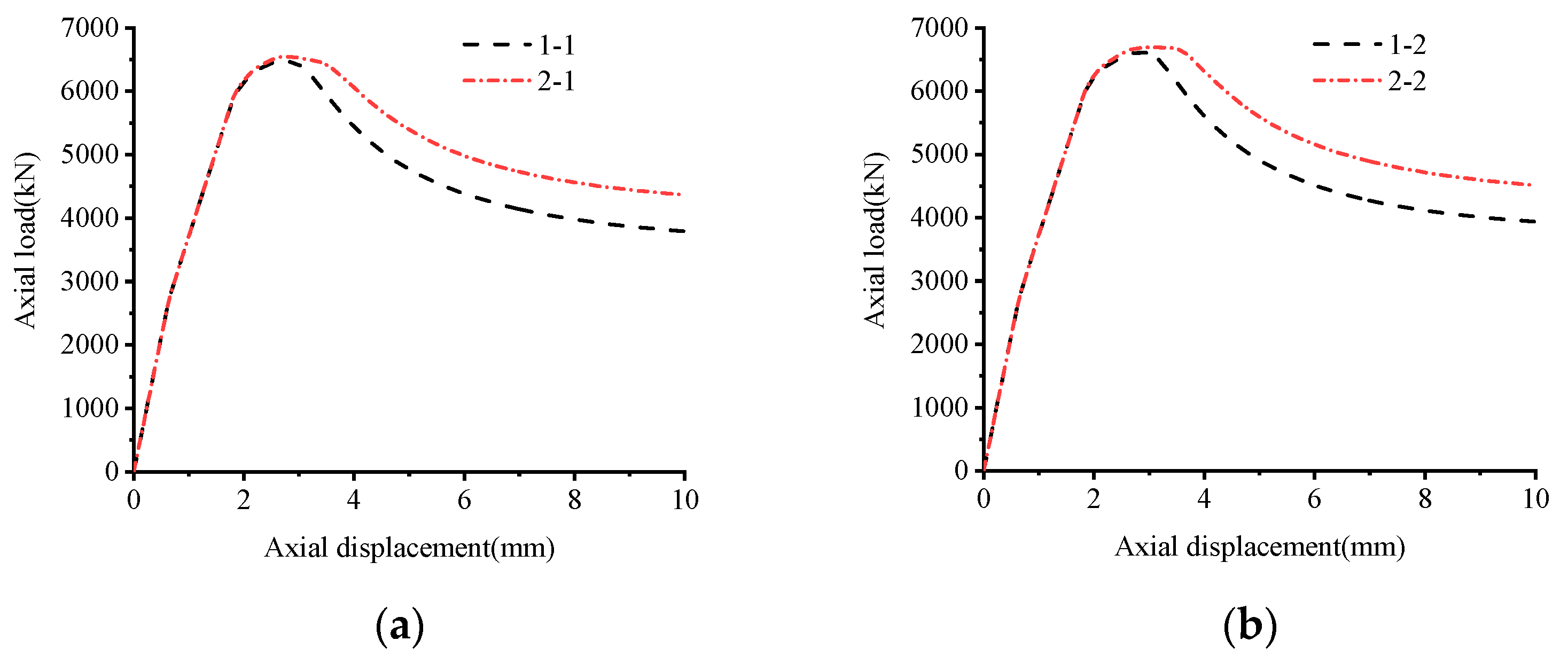
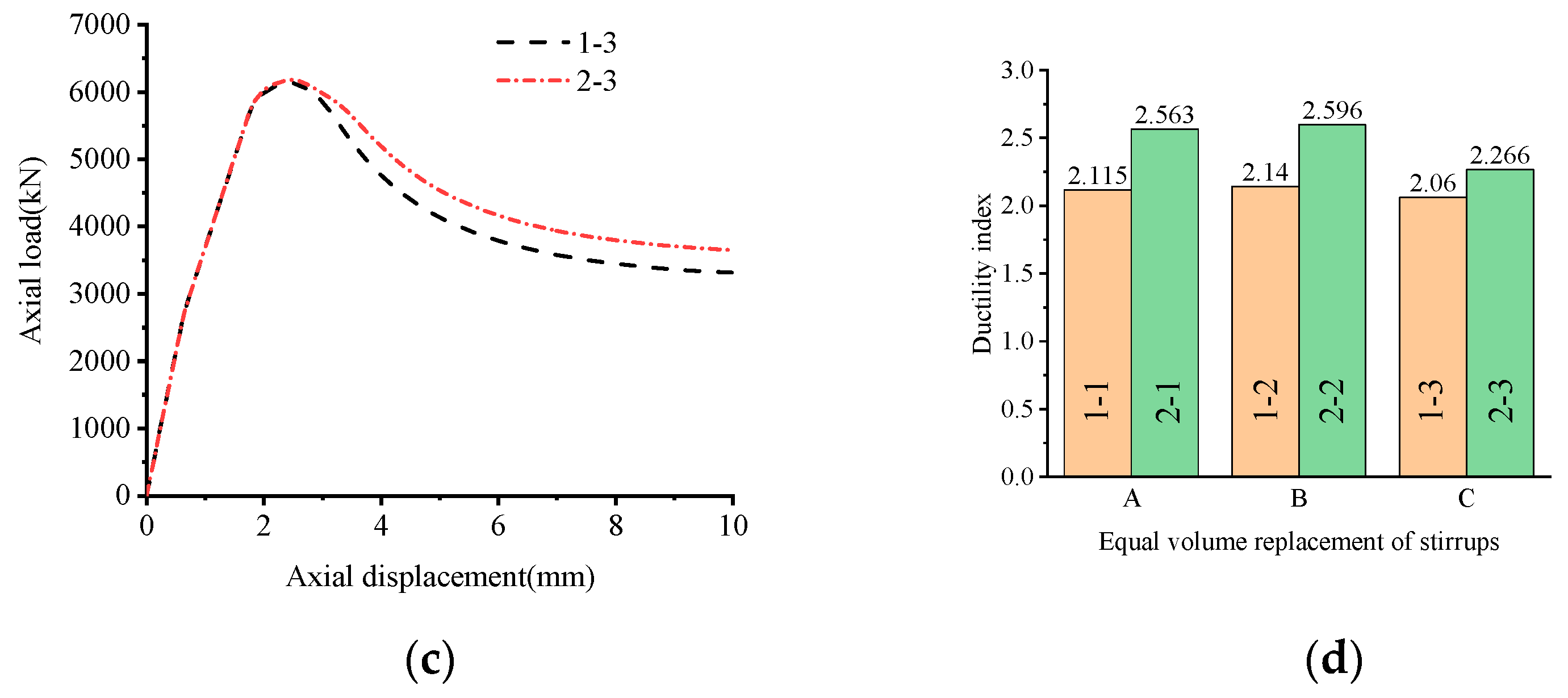
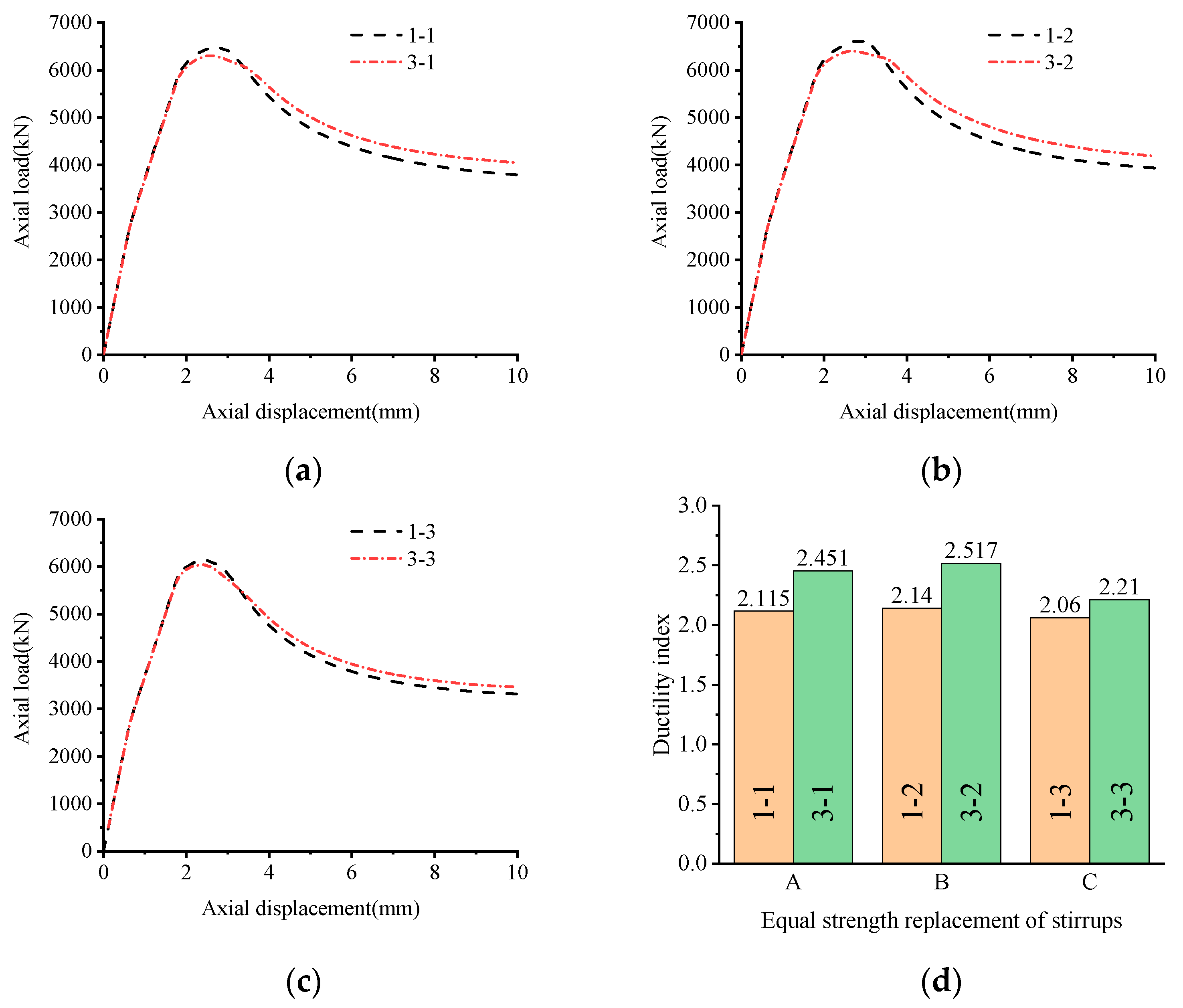

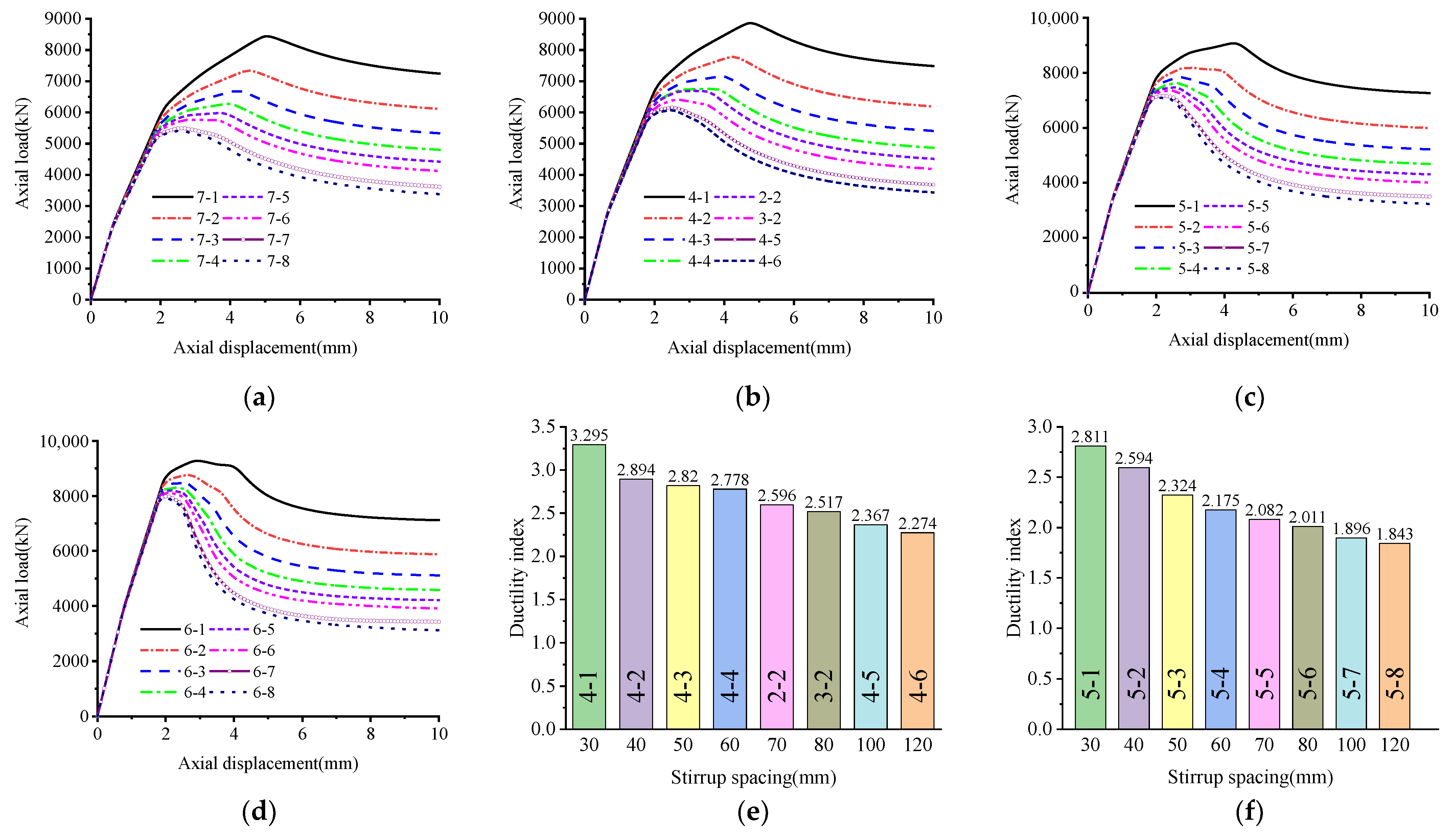
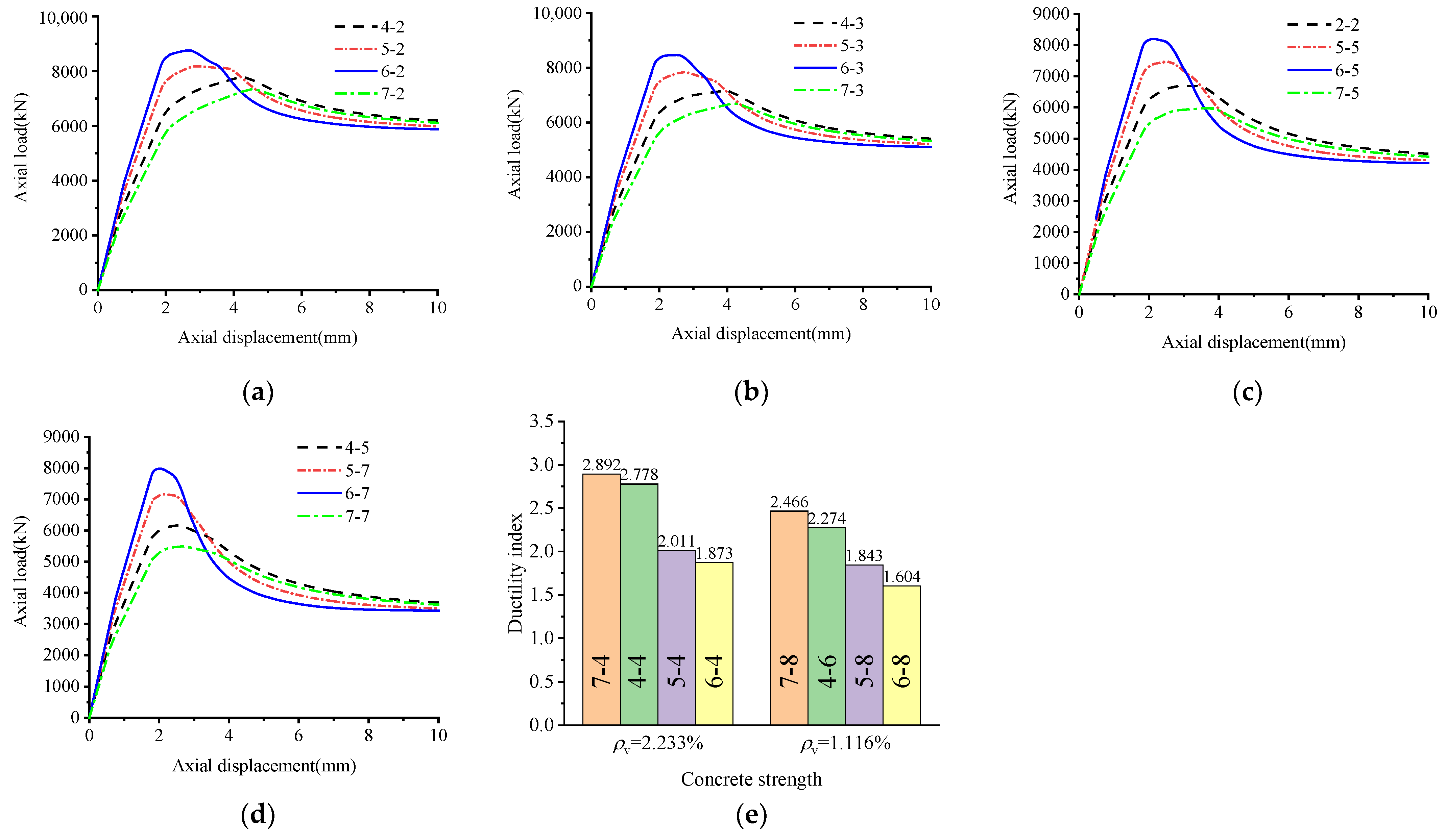
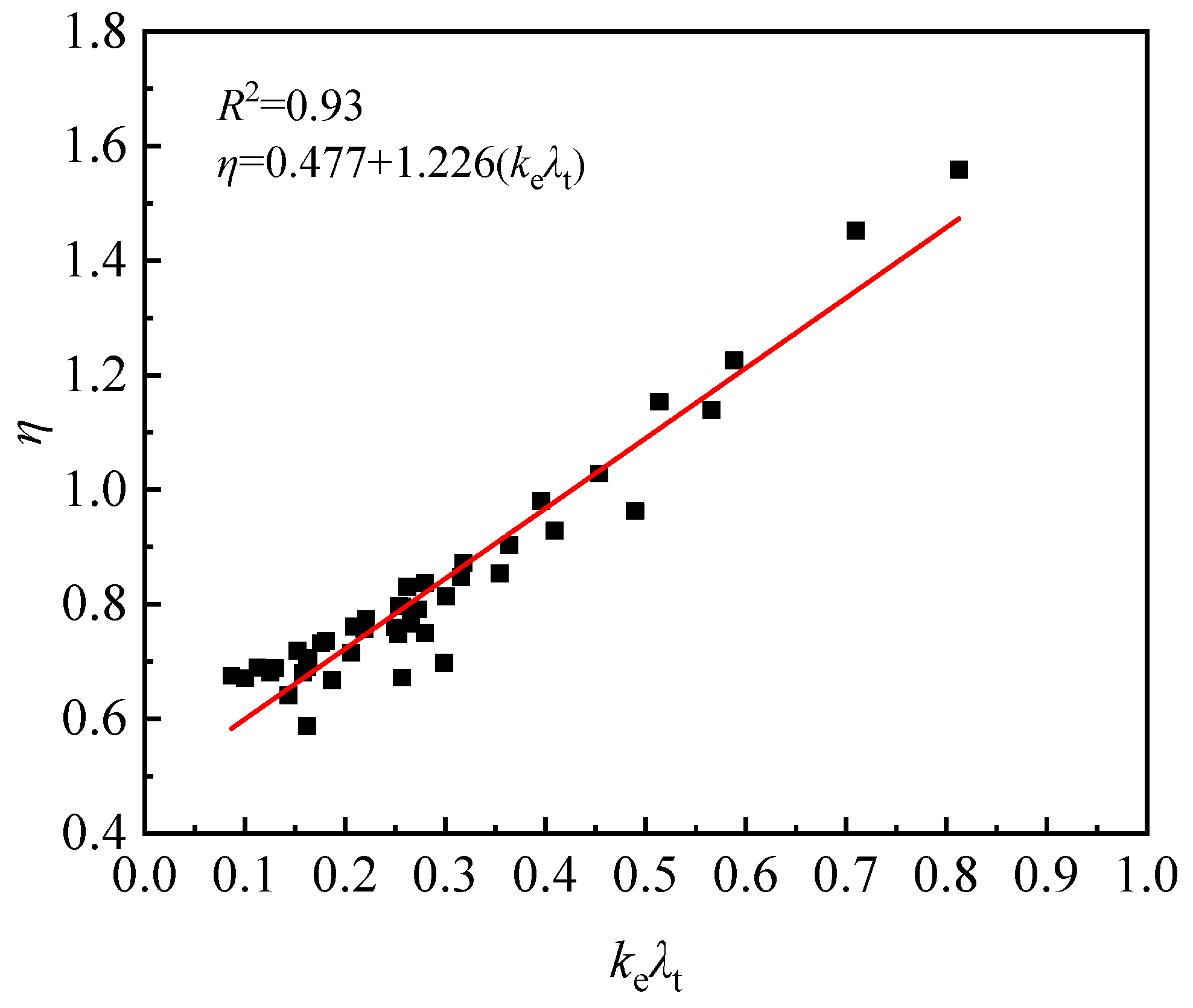
| Dilation Angle | Eccentricity | fb0/fc0 | K | Visibility Parameters |
|---|---|---|---|---|
| 30° | 0.1 | 1.16 | 0.6667 | 0.005 |
| Columns | Concrete | Longitudinal Reinforcement | Transverse Reinforcement | Axial Bearing Capacity | |||||
|---|---|---|---|---|---|---|---|---|---|
| fc (MPa) | fy (MPa) | Diameter (mm) | Type | fyv (MPa) | Diameter and Spacing | Nu,t (kN) | Nu,FE (kN) | Nu,t/Nu,FE | |
| AC1 | 30.7 | 479 | 20 | A | 437 | 8@60 | 6660 | 6474.48 | 1.03 |
| BC1 | 30.7 | 471 | 16 | B | 437 | 8@70 | 6228 | 6611.23 | 0.94 |
| AC2 | 30.7 | 479 | 20 | A | 629 | 8@60 | 6393 | 6497.95 | 0.98 |
| BC2 | 30.7 | 471 | 16 | B | 629 | 8@70 | 6389 | 6635.17 | 0.96 |
| AC3 | 30.7 | 479 | 20 | A | 629 | 8@90 | 6285 | 6182.26 | 1.02 |
| BC3 | 30.7 | 471 | 16 | B | 629 | 8@105 | 6283 | 6103.85 | 1.03 |
| AC4 | 30.7 | 615 | 16 | A | 629 | 8@60 | 6005 | 6224.46 | 0.96 |
| BC4 | 30.7 | 615 | 16 | B | 629 | 8@105 | 6335 | 6282.20 | 1.01 |
| BC5 | 30.7 | 615 | 16 | B | 629 | 8@70 | 6772 | 6926.31 | 0.98 |
| Average value | \ | 0.99 | |||||||
| Specimen ID | fc (MPa) | Longitudinal Reinforcement | Transverse Reinforcement | Peak Bearing Capacity (kN) | Ductility Index | ||||
|---|---|---|---|---|---|---|---|---|---|
| fy (MPa) | Diameter (mm) | Type | fyv (MPa) | Diameter and Spacing | Stirrup Ratio (%) | ||||
| 1-1 | 30.7 | 479 | 20 | A | 437 | Φ8@60 | 1.906 | 6474.48 | 2.115 |
| 1-2 | 30.7 | 471 | 16 | B | 437 | Φ8@70 | 1.914 | 6611.23 | 2.140 |
| 1-3 | 30.7 | 471 | 16 | C | 437 | Φ8@35 | 1.914 | 6131.7 | 2.060 |
| 2-1 | 30.7 | 479 | 20 | A | 590.67 | ΦRH8@60 | 1.906 | 6473.98 | 2.563 |
| 2-2 | 30.7 | 471 | 16 | B | 590.67 | ΦRH8@70 | 1.914 | 6612.31 | 2.596 |
| 2-3 | 30.7 | 471 | 16 | C | 590.67 | ΦRH8@35 | 1.914 | 6132.17 | 2.266 |
| 3-1 | 30.7 | 479 | 20 | A | 590.67 | ΦRH8@70 | 1.634 | 6310.31 | 2.451 |
| 3-2 | 30.7 | 471 | 16 | B | 590.67 | ΦRH8@80 | 1.675 | 6404.92 | 2.517 |
| 3-3 | 30.7 | 471 | 16 | C | 590.67 | ΦRH8@40 | 1.675 | 6038.82 | 2.210 |
| 4-1 | 30.7 | 471 | 16 | B | 590.67 | ΦRH8@30 | 4.466 | 8858.09 | 3.295 |
| 4-2 | 30.7 | 471 | 16 | B | 590.67 | ΦRH8@40 | 3.349 | 7779.06 | 2.894 |
| 4-3 | 30.7 | 471 | 16 | B | 590.67 | ΦRH8@50 | 2.679 | 7154.01 | 2.820 |
| 4-4 | 30.7 | 471 | 16 | B | 590.67 | ΦRH8@60 | 2.233 | 6761.43 | 2.778 |
| 4-5 | 30.7 | 471 | 16 | B | 590.67 | ΦRH8@100 | 1.340 | 6162.05 | 2.367 |
| 4-6 | 30.7 | 471 | 16 | B | 590.67 | ΦRH8@120 | 1.116 | 6070.07 | 2.274 |
| 5-1 | 38.5 | 471 | 16 | B | 590.67 | ΦRH8@30 | 4.466 | 9071.36 | 2.811 |
| 5-2 | 38.5 | 471 | 16 | B | 590.67 | ΦRH8@40 | 3.349 | 8177.48 | 2.594 |
| 5-3 | 38.5 | 471 | 16 | B | 590.67 | ΦRH8@50 | 2.679 | 7835.48 | 2.324 |
| 5-4 | 38.5 | 471 | 16 | B | 590.67 | ΦRH8@60 | 2.233 | 7621.1 | 2.175 |
| 5-5 | 38.5 | 471 | 16 | B | 590.67 | ΦRH8@70 | 1.914 | 7466.68 | 2.082 |
| 5-6 | 38.5 | 471 | 16 | B | 590.67 | ΦRH8@80 | 1.675 | 7345.34 | 2.011 |
| 5-7 | 38.5 | 471 | 16 | B | 590.67 | ΦRH8@100 | 1.340 | 7160.11 | 1.896 |
| 5-8 | 38.5 | 471 | 16 | B | 590.67 | ΦRH8@120 | 1.116 | 7085.07 | 1.843 |
| 6-1 | 44.5 | 471 | 16 | B | 590.67 | ΦRH8@30 | 4.466 | 9273.21 | 2.568 |
| 6-2 | 44.5 | 471 | 16 | B | 590.67 | ΦRH8@40 | 3.349 | 8759.18 | 2.144 |
| 6-3 | 44.5 | 471 | 16 | B | 590.67 | ΦRH8@50 | 2.679 | 8462.2 | 1.979 |
| 6-4 | 44.5 | 471 | 16 | B | 590.67 | ΦRH8@60 | 2.233 | 8302.29 | 1.873 |
| 6-5 | 44.5 | 471 | 16 | B | 590.67 | ΦRH8@70 | 1.914 | 8200.82 | 1.784 |
| 6-6 | 44.5 | 471 | 16 | B | 590.67 | ΦRH8@80 | 1.675 | 8119.83 | 1.721 |
| 6-7 | 44.5 | 471 | 16 | B | 590.67 | ΦRH8@100 | 1.340 | 7981.82 | 1.634 |
| 6-8 | 44.5 | 471 | 16 | B | 590.67 | ΦRH8@120 | 1.116 | 7914.69 | 1.604 |
| 7-1 | 26.8 | 471 | 16 | B | 590.67 | ΦRH8@30 | 4.466 | 8438.37 | 3.535 |
| 7-2 | 26.8 | 471 | 16 | B | 590.67 | ΦRH8@40 | 3.349 | 7338.39 | 3.214 |
| 7-3 | 26.8 | 471 | 16 | B | 590.67 | ΦRH8@50 | 2.679 | 6688.03 | 2.987 |
| 7-4 | 26.8 | 471 | 16 | B | 590.67 | ΦRH8@60 | 2.233 | 6274.11 | 2.892 |
| 7-5 | 26.8 | 471 | 16 | B | 590.67 | ΦRH8@70 | 1.914 | 5980.36 | 2.861 |
| 7-6 | 26.8 | 471 | 16 | B | 590.67 | ΦRH8@80 | 1.675 | 5765.34 | 2.832 |
| 7-7 | 26.8 | 471 | 16 | B | 590.67 | ΦRH8@100 | 1.340 | 5497.30 | 2.618 |
| 7-8 | 26.8 | 471 | 16 | B | 590.67 | ΦRH8@120 | 1.116 | 5410.48 | 2.466 |
| Specimen | Nu,FE (kN) | Nu,c (kN) | Nu,G (kN) | Nu,A (kN) | Nu (kN) | Nu,FE/Nu,c | Nu,FE/Nu,G | Nu,FE/Nu,A | Nu,FE/Nu |
|---|---|---|---|---|---|---|---|---|---|
| 2-1 | 6473.98 | 4964.00 | 4467.60 | 4017.89 | 5905.22 | 1.30 | 1.45 | 1.61 | 1.10 |
| 2-2 | 6612.31 | 4896.58 | 4406.92 | 3966.51 | 5847.05 | 1.35 | 1.50 | 1.67 | 1.13 |
| 2-3 | 6132.17 | 4896.58 | 4406.92 | 3966.51 | 5991.93 | 1.25 | 1.39 | 1.55 | 1.02 |
| 3-1 | 6310.31 | 4964.00 | 4467.60 | 4017.89 | 5728.15 | 1.27 | 1.41 | 1.57 | 1.10 |
| 3-2 | 6404.92 | 4896.58 | 4406.92 | 3966.51 | 5681.79 | 1.31 | 1.45 | 1.61 | 1.13 |
| 3-3 | 6038.82 | 4896.58 | 4406.92 | 3966.51 | 5824.68 | 1.23 | 1.37 | 1.52 | 1.04 |
| 4-1 | 8858.09 | 4896.58 | 4406.92 | 3966.51 | 7629.07 | 1.81 | 2.01 | 2.23 | 1.16 |
| 4-2 | 7779.06 | 4896.58 | 4406.92 | 3966.51 | 6847.32 | 1.59 | 1.77 | 1.96 | 1.14 |
| 4-3 | 7154.01 | 4896.58 | 4406.92 | 3966.51 | 6379.15 | 1.46 | 1.62 | 1.80 | 1.12 |
| 4-4 | 6761.43 | 4896.58 | 4406.92 | 3966.51 | 6068.39 | 1.38 | 1.53 | 1.70 | 1.11 |
| 4-5 | 6162.05 | 4896.58 | 4406.92 | 3966.51 | 5451.83 | 1.26 | 1.40 | 1.55 | 1.13 |
| 4-6 | 6070.07 | 4896.58 | 4406.92 | 3966.51 | 5300.01 | 1.24 | 1.38 | 1.53 | 1.15 |
| 5-1 | 9071.36 | 5852.08 | 5266.87 | 4779.35 | 8285.27 | 1.55 | 1.72 | 1.90 | 1.09 |
| 5-2 | 8177.48 | 5852.08 | 5266.87 | 4779.35 | 7553.32 | 1.40 | 1.55 | 1.71 | 1.08 |
| 5-3 | 7835.48 | 5852.08 | 5266.87 | 4779.35 | 7114.98 | 1.34 | 1.49 | 1.64 | 1.10 |
| 5-4 | 7621.1 | 5852.08 | 5266.87 | 4779.35 | 6824.02 | 1.30 | 1.45 | 1.59 | 1.12 |
| 5-5 | 7466.68 | 5852.08 | 5266.87 | 4779.35 | 6616.77 | 1.28 | 1.42 | 1.56 | 1.13 |
| 5-6 | 7345.34 | 5852.08 | 5266.87 | 4779.35 | 6462.05 | 1.26 | 1.39 | 1.54 | 1.14 |
| 5-7 | 7160.11 | 5852.08 | 5266.87 | 4779.35 | 6246.73 | 1.22 | 1.36 | 1.50 | 1.15 |
| 5-8 | 7085.07 | 5852.08 | 5266.87 | 4779.35 | 6104.59 | 1.21 | 1.35 | 1.48 | 1.16 |
| 6-1 | 9273.21 | 6587.08 | 5928.37 | 5424.47 | 8833.00 | 1.41 | 1.56 | 1.71 | 1.05 |
| 6-2 | 8759.18 | 6587.08 | 5928.37 | 5424.47 | 8127.49 | 1.33 | 1.48 | 1.61 | 1.08 |
| 6-3 | 8462.2 | 6587.08 | 5928.37 | 5424.47 | 7704.98 | 1.28 | 1.43 | 1.56 | 1.10 |
| 6-4 | 8302.29 | 6587.08 | 5928.37 | 5424.47 | 7424.52 | 1.26 | 1.40 | 1.53 | 1.12 |
| 6-5 | 8200.82 | 6587.08 | 5928.37 | 5424.47 | 7224.76 | 1.24 | 1.38 | 1.51 | 1.14 |
| 6-6 | 8119.83 | 6587.08 | 5928.37 | 5424.47 | 7075.62 | 1.23 | 1.37 | 1.50 | 1.15 |
| 6-7 | 7981.82 | 6587.08 | 5928.37 | 5424.47 | 6868.08 | 1.21 | 1.35 | 1.47 | 1.16 |
| 6-8 | 7914.69 | 6587.08 | 5928.37 | 5424.47 | 6731.07 | 1.20 | 1.34 | 1.46 | 1.18 |
| 7-1 | 8438.37 | 4418.83 | 3976.94 | 3489.12 | 7340.29 | 1.91 | 2.12 | 2.42 | 1.15 |
| 7-2 | 7338.39 | 4418.83 | 3976.94 | 3489.12 | 6522.76 | 1.66 | 1.85 | 2.10 | 1.13 |
| 7-3 | 6688.03 | 4418.83 | 3976.94 | 3489.12 | 6033.46 | 1.51 | 1.68 | 1.92 | 1.11 |
| 7-4 | 6274.11 | 4418.83 | 3976.94 | 3489.12 | 5708.20 | 1.42 | 1.58 | 1.80 | 1.10 |
| 7-5 | 5980.36 | 4418.83 | 3976.94 | 3489.12 | 5476.72 | 1.35 | 1.50 | 1.71 | 1.09 |
| 7-6 | 5765.34 | 4418.83 | 3976.94 | 3489.12 | 5303.90 | 1.30 | 1.45 | 1.65 | 1.09 |
| 7-7 | 5497.30 | 4418.83 | 3976.94 | 3489.12 | 5063.41 | 1.24 | 1.38 | 1.58 | 1.09 |
| 7-8 | 5410.48 | 4418.83 | 3976.94 | 3489.12 | 4904.65 | 1.22 | 1.36 | 1.55 | 1.10 |
| Mean value | \ | \ | \ | \ | \ | 1.36 | 1.51 | 1.68 | 1.11 |
| SD | \ | \ | \ | \ | \ | 0.17 | 0.19 | 0.22 | 0.03 |
| Specimen | Nu,t (kN) | Nu,c (kN) | Nu,G (kN) | Nu,A (kN) | Nu (kN) | Nu,t/Nu,c | Nu,t/Nu,G | Nu,t/Nu,A | Nu,t/Nu |
|---|---|---|---|---|---|---|---|---|---|
| AC2 | 6393 | 4964.00 | 4467.60 | 4017.89 | 5971.02 | 1.29 | 1.43 | 1.59 | 1.07 |
| BC2 | 6389 | 4896.58 | 4406.92 | 3966.51 | 5914.88 | 1.30 | 1.45 | 1.61 | 1.08 |
| AC3 | 6285 | 4964.00 | 4467.60 | 4017.89 | 5532.17 | 1.27 | 1.41 | 1.56 | 1.14 |
| BC3 | 6283 | 4896.58 | 4406.92 | 3966.51 | 5447.59 | 1.28 | 1.43 | 1.58 | 1.15 |
| AC4 | 6005 | 4749.47 | 4274.53 | 3869.29 | 5588.18 | 1.26 | 1.40 | 1.55 | 1.07 |
| BC4 | 6335 | 5243.83 | 4719.45 | 4244.31 | 5971.32 | 1.21 | 1.34 | 1.49 | 1.06 |
| BC5 | 6772 | 5243.83 | 4719.45 | 4244.31 | 6483.55 | 1.29 | 1.43 | 1.60 | 1.04 |
| Average value | \ | \ | \ | \ | \ | 1.27 | 1.41 | 1.57 | 1.09 |
| Standard deviation | \ | \ | \ | \ | \ | 0.03 | 0.03 | 0.04 | 0.04 |
Disclaimer/Publisher’s Note: The statements, opinions and data contained in all publications are solely those of the individual author(s) and contributor(s) and not of MDPI and/or the editor(s). MDPI and/or the editor(s) disclaim responsibility for any injury to people or property resulting from any ideas, methods, instructions or products referred to in the content. |
© 2023 by the authors. Licensee MDPI, Basel, Switzerland. This article is an open access article distributed under the terms and conditions of the Creative Commons Attribution (CC BY) license (https://creativecommons.org/licenses/by/4.0/).
Share and Cite
Zhao, L.; Zhu, Q.; Wang, H.; Lian, J. Analysis of Axial Compression Performance of Concrete Stub Column with CRB600H Stirrups. Buildings 2023, 13, 195. https://doi.org/10.3390/buildings13010195
Zhao L, Zhu Q, Wang H, Lian J. Analysis of Axial Compression Performance of Concrete Stub Column with CRB600H Stirrups. Buildings. 2023; 13(1):195. https://doi.org/10.3390/buildings13010195
Chicago/Turabian StyleZhao, Lijie, Qifeng Zhu, Hao Wang, and Jijian Lian. 2023. "Analysis of Axial Compression Performance of Concrete Stub Column with CRB600H Stirrups" Buildings 13, no. 1: 195. https://doi.org/10.3390/buildings13010195
APA StyleZhao, L., Zhu, Q., Wang, H., & Lian, J. (2023). Analysis of Axial Compression Performance of Concrete Stub Column with CRB600H Stirrups. Buildings, 13(1), 195. https://doi.org/10.3390/buildings13010195







